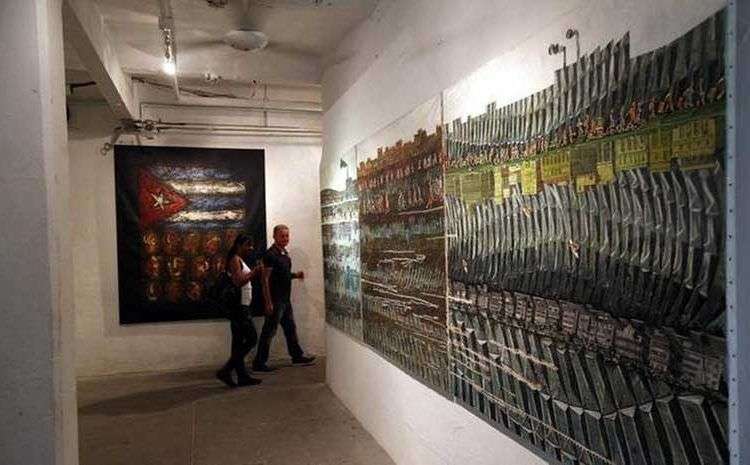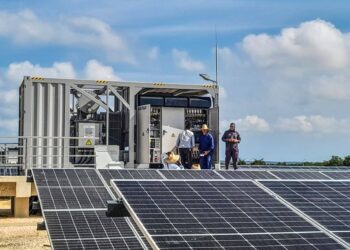By: Ruben Ramirez del Alma
Solveig Font is one of the specialists in plastic arts of the Cuban Art Factory. Previously he has ventured into conservatorship; his most famous works are ¨ Somos la misma cosa, ¨at UNEAC´s Villena Hall, and collateral to the development of the 11th Havana Biennial, the curatorial work and production of American photographer Michael Dweck’s personal sample on the photographic library of Cuba in 2012. Besides being a specialist for four years of Villa Manuela gallery.
The Cuban Art Factory (FAC by its Spanish acronym) opened its doors a few months ago in the space of the former El Cocinero oil factory, an evident appointment to the Tate Modern in London although its spirit is far from this, but that may be due to a intention to combine industrial character with art, and also a certain sense of genesis, that is, a space where artistic and cultural processes are generated and accompanied. My first question goes over here.
Is FAC a space where young people can aspire to obtain financing for their projects, develop new works, or gestate creative process under the guidance of specialists; or you just choose some works within the already made by certain artists to exhibit them according to your specific interests?
The FAC may be the place where, indeed, there is the possibility of obtaining funding for artistic projects. Now is not the time, we must still walk a little more to have with what to fund these projects. We are still in diapers as they say; it’s only been nine months after the opening of FAC. Although this is one of the intentions we have for the future. We are also interested in new works to be conceived regarding space, this has happened before, and indeed, we are designing projects where the creation of new works is one of the main motivations of the exhibition. We are very interested in creative processes to be gestated, either under our advice, we as producers or even in collaboration with other spaces and institutions. In this sense many variants may happen as types of curatorial works and projects are, and we are always willing to help.
It has often happened that the works to be exhibited are chosen from a set already available of different artists, i.e. they are works made before any curatorial request, and we will provide them functionalism. That, in my opinion, has no negative connotation because a choice is not at risk of being bad although its works are not novices. Many of the exhibits taking place in the world follow this procedure. When I started working in FAC, there were only fifteen days to the opening, and to assume a coherent and adjusted to time curatorship, so I had to appeal to the artists with whom I had worked before, because I knew their work and were accessible. I proposed an open issue as possible as that of being in an old factory, by implying its walls, piping, its museum peculiarity, besides the manufacturing environment itself.
Thanks to that in a short time we were able to open and, of course, I counted on with works that already existed and known artists, despite our desire is to continue exploring new terrain. We are also interested in being inclusive and not just for young people but for all those generations who wish to join us.
The second presentation had to do with those materials of everyday life that go unnoticed to us, because they are disposable items that you do not give them the importance they deserve. There were artists working with these materials, which by prior knowledge of their works could reach them. Research, suggestions and comments led us to find works and artists we do not know, but that came together nicely in the space.
The economic potential of artworks currently is no secret to anyone. How do you solve this issue? Do you make sell negotiations, or before that, are you allowed to do them? What do you do to pay the promotional contract you have with the artists?
Right now the FAC does not have a marketing authorization, so we can not sell artworks. If a person is interested in purchasing a work of art, Cuban or foreigner, we put him in touch with the artist and the other agreements are for them. Basically we act as a link of conversation.
What is the procedure for accessing as an artist to exhibit or present your work in the FAC ?
The procedure is simple. The artist m ust submit a work or exhibition draft and this goes through the curators of the place. If we are interested in the work for a curatorial project, we notify the artist and we can reach an agreement. If it is an exhibition project for the space, we first discuss it with the curator who presents it, we see the quality of the proposal, which must be in tune with the FAC, must know well how this works, and the pieces must not be extremely vulnerable to be damaged. All this is important in order to make the museology, we offer advice on space because we are who know it the best.
We are always open to new projects to be submitted by both curators and artists. So far we have not been making solo exhibitions since we pretend as many artists as possible to be presented during the period of a year or so. Not because these selections to be of fifty, but because we feel that there is much interest in exhibiting at FAC and it is important that more than an artist to have that opportunity for three months.
With so many diverse activities such as film screenings, staging of theater plays, musical concerts and visual arts, you take the risk of incoherence. The worth everything is most criticized in this space. Do the specialists work together to achieve synergy among the various means? Does programming respond to certain thematic cycles or actions related to each other?
Yes, all specialists work together, although this does not imply that all areas, not all experts to be focused on the same subject, but there is indeed a mutual understanding. Every week we met for everyone to have the information of what is happening, and if for example, a play addressing a particular case is going to be shown and there may be a film that is related to this, so we can screen it. There is communication between us, but it is complicated to have every week associated things, especially because a play and a film screening can last a week or a month, while an exhibition inhabits the space for three months, plus each manifestation maintains some autonomy. The same dizzying and changing dynamics of FAC makes us sometimes to assume a similar format to that of a festival of various means.
The night life at FAC is pretty hectic, there is a disco atmosphere between the dancefloor and beverage, many people do not stop to observe the works, for them they acquire a decorative function. Taking into account that complicated feature of the space, which can be a possible strategy for future exhibitions to call more attention from the public, or to get organically integrated with it?
One of the main strategies is that from January the FAC will also open at daytime. For the space to gain a prominent place as gallery, and counteracting thus the impression that some people have on the environmental function of the works. Although I do appreciate the importance, of course, of the works that have been exhibited. P eople always take some information of them, and most of them eventually run the showrooms. Because, in addition, not everyone wants or can come to FAC to watch a play, listen to a concert, or share a few drinks. There are also many people at night, mostly young people who come to have fun, and this is not totally ideal for those who want to observe in detail the exhibition.
Another thing we want to achieve is a major public interaction with the works, not all, not always, but in some of them, or in some projects, one of our main concerns is that one . To call the attention of the public is important at all times.
Tell us about upcoming projects.
I think the next exhibition on February can be very interesting. It has to do with advertising done by the plastic artists, often also in relation to the design and designers. For the Havana Biennial we have a project which can tentatively be called “Process”, although this name is not definitive. We will work on transdisciplinarity of certain works with sound and music, that is, something bolder on art sound. We intend offering visual and auditory information through museography and the boundaries between means of the works that we present to cease existing. This exhibition has a decisive value to FAC, as it means that we will become culturally bigger and shall win a place in the most serious contemporary Cuban art circuit.










